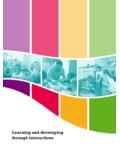Transcription of Learning and developing through play - ncca.biz
1 Learning and developing through play53 Learning and developing through playAistear: the Early Childhood Curriculum Framework IntroductionChildren love to play , and play often mirrors what is important in their lives. When asked about play children talk about having fun, being with friends, choosing activities themselves, and being outdoors. play can be quiet or noisy, messy or orderly, funny or serious, strenuous or effortless. It can take place inside or outside and develops as children grow and change. Children play for different reasons. Sometimes they are exploring or Learning new things. At other times they are consolidating existing Learning or practising a skill. play can also be a way of building or strengthening a relationship.
2 Children often play simply for fun and enjoyment. They bring their own interpretations of situations, events, experiences, and expectations to their play . Children need time to develop their play . They like having spaces inside and outside, and often enjoy playing with other children and adults. They also need props such as toys, equipment and real objects to play with and manipulate. They love to make choices about when, what, where, how, and with whom to play . These guidelines offer information and suggestions on how the adult can extend and enrich children s Learning and development through is play ? play is a way of doing things . Table 7 outlines some of its characteristics in alphabetical order.
3 Table 7: Characteristics of play CharacteristicDescriptionActiveChildren use their bodies and minds in their play . They interact with the environment, with materials and with other and riskyPlay helps children to explore the unknown. The pretend element offers a safety net that encourages children to take share information and knowledge through their play . Their communication can be verbal or non-verbal, simple or complex. Enjoyable play is fun and exciting, and involves a sense of become deeply absorbed and focused in their play , concentrating and thinking about what they are play about what they have seen and heard, and what they know. play helps them to build and extend their knowledge, understanding and skills in a way that makes sense to and interactiveChildren play alongside or with others.
4 Sometimes they also like and need to play alone. SymbolicChildren imagine and pretend when they are playing. They try out ideas, feelings and roles. They re-enact the past and rehearse the future. This can involve them reading and writing long before they develop these helps children to express and work through emotions and Children choose to play . Their play is spontaneous. They shape it as they go, changing the characters, events, objects, and locations. Are there different types of play ?There are many different types of play and children can be involved in more than one type at any time. For example, children often pretend they are builders (pretend play ) when they are constructing a tower or a road (constructive play ).
5 Likewise babies can initiate peek-a-boo (games with rules) while investigating a piece of fabric (exploratory play ). While children may show preferences for one type of play it is important that they experience a variety of types to support their Learning and development across the four themes of Well-being, Identity and Belonging, Communicating, and Exploring and Thinking. Table 8 describes different types of play in alphabetical order. 54 Learning and developing through playAistear: the Early Childhood Curriculum Framework Table 8: Categorising playType of playDescriptionCreativeCreative play involves children exploring and using their bodies and materials to make and do things and to share their feelings, ideas and thoughts.
6 They enjoy being creative by dancing, painting, playing with junk and recycled materials, working with play -dough and clay, and using their imaginations. Games with rulesAnother type of play involves games with rules. Even babies and toddlers can partake in these, as peek-a-boo and turn-taking games have rules. In the beginning children often play by their own rather flexible rules! In time they also partake in more conventional games with external rules. Language is an important part of games with rules as children explain, question and negotiate the rules. Rules are often an important part of pretend play where children negotiate rules about what can and can t be play involves children playing with sounds and words.
7 It includes unrehearsed and spontaneous manipulation of these, often with rhythmic and repetitive elements. Children like playing with language enjoying patterns, sounds and nonsense words. They also love jokes and funny play involves children developing , practising and refining bodily movements and control. It includes whole body and limb movements, co-ordination and balance. These activities involve physical movements for their own sake and enjoyment. Children gain control over their gross motor skills first before refining their fine motor play involves children using physical skills and their senses to find out what things feel like and what can be done with them. Children explore their own bodies and then they explore the things in their play involves practising and refining motor skills.
8 This type of play enhances physical dexterity and hand-eye co-ordination. Over time children need to experience a range of different levels of manipulation if they are to refine their motor skills. This type of play includes manipulating objects and play involves building something using natural and manufactured materials. As children develop, this type of play can become more complex and , dramatic, make-believe, role, and fantasy play involves children using their imaginations. It includes pretending with objects, actions and situations. As children grow, their imaginations and their play become increasingly complex. Children use their developing language to move from thinking in the concrete to thinking in the abstract.
9 They make up stories and scenarios. Children act out real events and they also take part in fantasy play about things that are not real, such as fairies or super heroes. Children try out roles, occupations and experiences in their pretend literary and numeracy are clearly evident in this type of play , for example children make lists and menus and pay for cinema tickets. They also get the chance to play with different forms of ICT such as mobile phones, keyboards, cameras, and calculators. Small world play involves children using small-scale representations of real things like animals, people, cars, and train sets as play props. Socio-dramatic play involves children playing with other children and/or adults.
10 It provides opportunities for children to make friends, to negotiate with others, and to develop their communication skills. This play helps extend language. The ability to write stories also has its roots in socio-dramatic Appendix 1 for examples of resources that can be used to support these different types of play . 1 Physical play is used to refer to physical, exploratory, manipulative, and constructive Pretend play is used to refer to pretend, make believe, dramatic, socio-dramatic, role, fantasy, and small world and developing through playAistear: the Early Childhood Curriculum Framework Sometimes individual children like to play alone and sometimes they enjoy playing with others:Solitary play The child plays play The child watches others playing without joining play The child plays side by side with another child, often with similar materials, but without interacting.









